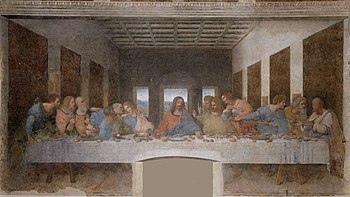Last Supper
The Last Supper is the final meal that, in the Gospel accounts, Jesus shared with his apostles in Jerusalem before his crucifixion.[1]

The Apostle Paul tells of this supper in his first letter to the Corinthians. The Synoptic Gospels all tell of Jesus using the bread and wine as symbols of his body and blood. the Gospel of John does not include those details but tells of Jesus washing the feet of the disciples. This has led to some Christian groups having a ritual of foot washing as a sign of humility.
The Last Supper is commemorated by Christians especially on Maundy Thursday.[2] The Last Supper provides the purpose for Eucharist, also known as "Holy Communion" or "The Lord's Supper".[3]
How it is celebrated change
Christian groups have different ways to celebrate this event. The Roman Catholic mass is observed at least weekly. Lutheran, Episcopal and other denominations also do this, but their understanding of its meaning is not identical to that of the Roman Catholics. Other denominations celebrate no more than 4 times a year. Some Christian groups such as the Salvation Army do not celebrate it at all. Churches which celebrate the last supper usually have fixed rituals that are used. This is followed by the believers receiving small pieces of bread and a sip of wine or grape juice. Some churches practice "closed" communion. This means only members of the church can participate. Others, such as Methodists allow all those present to participate. Churches with closed communion may also deny their own members if they are not living according to the rules of the church.
The Meaning of the Celebration change
The historical Roman Catholic view is that in the Eucharist the bread and wine actually turn into the real body and blood of Jesus, even though their appearance does not change. This would mean that celebrating the Eucharist adds to the sacrifice of Jesus on the Cross. They say it takes away pain or guilt from a person for whom it is celebrated. Protestants say this is wrong. They believe that the celebration helps Christians to remember that Jesus died for them. The sacrifice of Jesus was complete and perfect, and nothing needs to be added to it. The Anglican Church states this clearly in Article 31 of their Articles of faith. [4]
References change
- ↑ "Last Supper. The final meal Christ with His Apostles on the night before the Crucifixion.", Cross, F. L., & Livingstone, E. A. (2005). The Oxford Dictionary of the Christian Church (3rd ed. rev.) (958). Oxford; New York: Oxford University Press.
- ↑ Gwyneth Windsor, John Hughes (21 November 1990). Worship and Festivals. Heinemann. ISBN 978-0435302733. Retrieved 11 April 2009.
On the Thursday, which is known as Maundy Thursday, Christians remember the Last Supper which Jesus had with His disciples. It was the Jewish Feast of the Passover, and the meal which they had together was the traditional Seder feast, eaten that evening by the Jews everywhere.
- ↑ Walter Hazen (1 September 2002). Inside Christianity. Lorenz Educational Press. ISBN 978-0787705596. Retrieved 3 April 2012.
The Anglican Church in England uses the term Holy Communion. In the Roman Catholic Church, both terms are used. Most Protestant churches refer to it simply as communion or The Lord's Supper. Communion reenacts the Last Supper that Jesus ate with His disciples before he was arrested and crucified.
- ↑ http://anglicansonline.org/basics/thirty-nine_articles.html